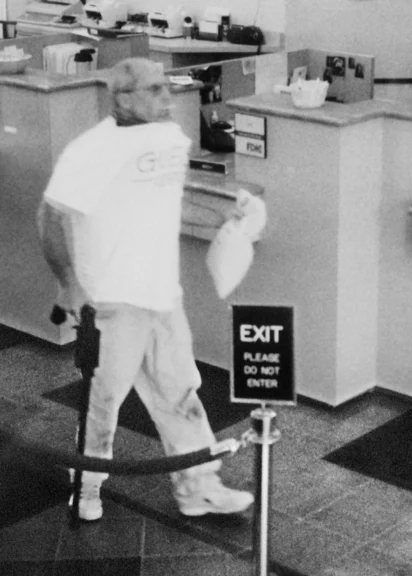On August 28, 2003, 46-year-old pizza delivery man Brian Wells walked into a PNC bank in Erie, Pennsylvania, with a massive metal collar around his neck, covered by a T-shirt. He gave the teller a multi-page rambling note demanding $250,000 in cash.
While Wells was waiting for the money, he grabbed a lollipop from a bowl on the teller’s desk and leaned on a cane, which was later determined to be a working gun disguised as a cane. The bank didn’t have $250,000 lying around, so Wells was only able to walk out with a bag stuffed with less than $9,000. Witnesses would later say he walked out of the bank swinging the cane and didn’t seem fearful or nervous at all.
Outside, Wells attempted to follow directions that would allow him to remove the collar around his neck, which he had told bank employees was wired to a bomb. Wells was barely out of the bank a few minutes before police surrounded him and placed him in handcuffs.

Credit: CCTV. AP.
While sitting cross-legged on pavement, Wells told the police officers that he had a bomb around his neck that would explode.
“Why isn’t anybody trying to get this thing off me?” he asked them.
Soon, a beeping could be heard from the collar, and Wells became more desperate for help. Not long after, the bomb exploded, killing Wells instantly.
The images of that day have not been forgotten, and while we know who was behind the bank heist plot, one question remains to this day: Why was no one ever held responsible for Wells’ death?
The answer surely comes from the law enforcement’s determination that Wells was a co-conspirator in the plot and, subsequently, his own death. But that raises a similar question: Why, after all that we now know, is Wells still considered a co-conspirator?
His family certainly insists that he could not have been part of the plot. His sister, Jean Heid, told CNN in 2011 that her brother was “innocent 100 percent.”
“They screwed up big time,” Heid said, referring to the officers present went Wells died. “They let an innocent man, my brother, die while in their custody and they didn’t even lift a finger to help him.”
“This case is going to be looked at for years to come, and they don’t want it known that they screwed up,” she added. “Brian never would have done this.”
The evidence that Wells was involved in the plot has always been shaky. The main person who claimed Wells was in on the whole thing was Kenneth Barnes, a convicted crack dealer who was convicted for playing a role in the bank heist. Barnes had every reason to lie about Wells. If Wells was involved, then Barnes and the other co-conspirators couldn’t be charged with his murder, which could have landed them on death row. Barnes was sentenced to 45 years in prison for the bomb plot, but his sentence was reduced to 20 years after he testified against another co-conspirator.
An FBI agent, in a court affidavit, said another witness corroborated Barnes’ story. There was also a witness who claimed he saw Wells driving away from a home where the bomb plot was concocted on the day before the bank robbery. There is no evidence to suggest Wells was there collaborating with his killers – for all the witness knew, Wells was simply delivering a pizza to the people who planned to use him for their plot.
And the FBI maintained that even if Wells was involved, his role was limited to some of the early planning stages, and that he was never willing to wear the bomb collar that caused his death.
“We have reason to believe that at some point that he was coerced, that it was placed on his neck by another individual,” U.S. Attorney Mary Beth Buchanan told NBC News in 2007.
One reason authorities came to believe Wells was involved was his demeanor inside the bank. He was reportedly calm and did things that someone forced to rob a bank against their will would not have done. But perhaps that was Wells’ nerves showing, just not in the way one would expect.
Wells’ connection to the co-conspirators was through a prostitute he frequented named Jessica Hoopsick, who knew Kenneth Barnes. In the 2018 Netflix documentary “Evil Genius,” Hoopsick admitted to setting Wells up for the crime, even though she described him as a friend. She said that Barnes promised her drugs and money for the name of a person he and his co-conspirators could use to rob the bank. Hoopsick insisted Wells knew nothing about the robbery plans and wasn’t in on the planning.
It doesn’t appear any follow-ups have been conducted since Hoopsick’s bombshell revelation.
Another blow to the idea that Wells was involved comes from the random nature of the call that led him to the radio tower where the collar was placed on his neck. His boss at the pizza restaurant where he worked answered the phone but couldn’t understand the person on the other line. His boss then handed the phone to Wells, who took down the order. Maybe Wells was hovering, waiting for a call at that moment, or maybe it was a complete coincidence that he happened to be the one nearby to take the order. Had another employee taken the call, or another delivery driver gotten the assignment, would they have been the one in the collar?
While authorities are reportedly unconvinced that Wells was an innocent victim, there is no doubt that Kenneth Barnes, Floyd Stockton, William Rothstein, and Marjorie Diehl-Armstrong were involved.
How their involvement was discovered, however, was a story all its own.
Police had no leads as to who was behind the bomb plot, and were struggling to solve the case, until September 20, 2003 – nearly a month after Wells’ death. Rothstein, a handy-man and part-time shop teacher who always wanted everyone to know he was the smartest man in the room, called 911 on that day to report a dead body in the freezer in his garage.
The body turned out to be that of James Roden, Diehl-Armstrong’s boyfriend, whom she had killed before asking Rothstein to dispose of the body. Rothstein explained to police that he humored Diehl-Armstrong about disposing of the body so that he could report her to police.
Diehl-Armstrong, a former valedictorian who was bipolar and a shadow of her former self, was charged with killing her boyfriend Rosen. Diehl-Armstrong had previously gone on trial for killing another boyfriend in 1984, but she claimed self-defense and was acquitted. Following that death, several other men associated with Diehl-Armstrong died under mysterious circumstances.

Photo courtesy Erie Police/Getty Images
Diehl-Armstrong pleaded guilty, but mentally ill, to killing Rosen and was originally sent to Mayview State Hospital, but later transferred to a state prison.
Rothstein, meanwhile, died of cancer at the age of 60. A previous suicide note he had written stated that his would-be suicide had nothing to do with the Wells case, a curious inclusion. On his death bed, he refused to discuss the Wells case with investigators.
During this time, investigators linked Rothstein and Diehl-Armstrong to the payphone that was used to call the pizza restaurant where Wells worked to order the pizza that kicked off the bank heist.
Police eventually spoke to Floyd Stockton, who was Rothstein’s roommate at the time Wells was murdered and who was a fugitive on a rape charge involving a disabled teenager. Stockton told police that Rothstein and Diehl-Armstrong were involved in the bomb plot. Rothstein reportedly needed $250,000 to satisfy family members looking to sell the family home in which he lived. Diehl-Armstrong wanted the money to pay Kenneth Barnes to kill her father, who was giving away her inheritance.
It is believed Rothstein built the bomb and obtained some parts for it from Diehl-Armstrong, but he died before he could be charged.
Diehl-Armstrong at times gave information about the Wells case but denied her own involvement. It was never clear when she was lying and when she was telling the truth. She was charged with the bomb plot in 2007, convicted to life in prison without the possibility of parole in 2011, and died in prison on April 4, 2017, at the age of 68.
Barnes also died in prison, on June 20, 2019, at the age of 65. He had been Diehl-Armstrong’s “fishing buddy” prior to their involvement in Wells’ death.
Stockton was granted immunity for cooperating with law enforcement and died on August 10, 2022, at the age of 75.

Continue reading this exclusive article and join the conversation, plus watch free videos on DW+
Already a member?

.png)
.png)

